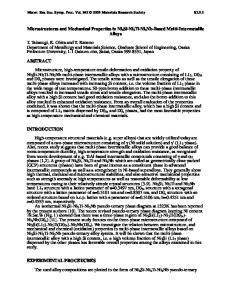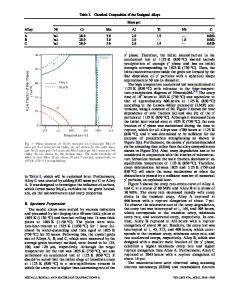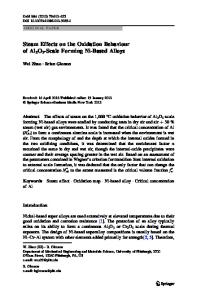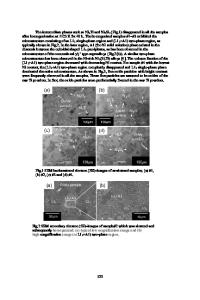The Development of Alloys Based on Ni 3 Si
- PDF / 565,975 Bytes
- 6 Pages / 420.48 x 639 pts Page_size
- 42 Downloads / 687 Views
THE DEVELOPMENT OF ALLOYS BASED ON Ni 3 Si W. C. Oliver Metals and Ceramics Division, TN 37831
Oak Ridge National Laboratory,
Oak Ridge,
ABSTRACT
Alloys with large volume fractions of the intermetallic phase Ni 3 Si have unique aqueous corrosion resistance that provides the driving force for an alloy design program to improve their generally poor room temperature mechanical properties. The target of the alloy design program at Oak Ridge National Laboratory was to produce wrought alloys with at least 10% room temperature ductility while retaining good aqueous corrosion resistance. In this paper several important findings will be discussed. These include macro and micro alloying (B, C, Be) to produce superplastic wrought alloys with high strength and high room-temperature ductility. Some of the alloys developed are strong enough to be0competitive with medium temperature structural alloys such as Inconel 718.
INTRODUCTION Thg intermetallic compound Ni 3 Si is the major constituent of Hastelloy alloy D , a corrosion-resistant alloy with unique ability to resist attack by sulfuric acid solutions. HASTELLOY alloy D is a cast alloy with relatively poor mechanical properties. It not only has low room temperature ductility but is also difficult to hot fabricate. Significant past alloy development on Ni 3 Si based alloys is largely due to Williams et al. [1-3]. They found that additions of Ti to the alloys greatly improved their as-cast properties. In addition, they developed several high-strength alloys and improved the alloys' corrosion resistance. Other research of note include the discovery of anomalous yield behavior in Ni 3 Si [4] and microalloying effects [9-101. An alloy development program was undertaken at Oak Ridge National Laboratory to produce wrought alloys based on Ni 3 Si with at least 10% ductility and as high strength as possible.
EXPERIMENTAL The alloys studied were made by arc melting pure metals and drop casting ingots 1.25 cm x 2.5 cm x 12.5 cm. The alloys were then hot rolled to approximately 1.5 mm sheet at 1080*C. The alloys were then annealed at 0 various temperatures between 850 and 1000 C for at least 4 h. This heat treatment was varied to try to obtain the maximum room temperature (R.T.) ductility achievable for each alloy. Specimens were fabricated from the sheet in two ways. If the R.T. ductility was greater than 10%, specimens were punched from the sheet, otherwise the specimens were electro-discharge machined. Subsequent to these operations, the surfaces of the specimens were ground until a gauge section of approximately I mm x 2.5 mm x 12.5 mm was obtained. The specimens were then heat treated at 850%C for 4 h prior to testing. Two test atmospheres were used; lab air and a vacuum of I x 10-6 torr. Hastelloy is a Registered Trademark of Haynes International, Inc. Inconel is a Registered Trademark of INCO Family of Companies.
Mat. Res. Soc. Symp. Proc. Vol. 133. e1989 Materials Research Society
398
RESULTS AND DISCUSSION Figure 1 shows the elongation to fracture and the yield strengt
Data Loading...











